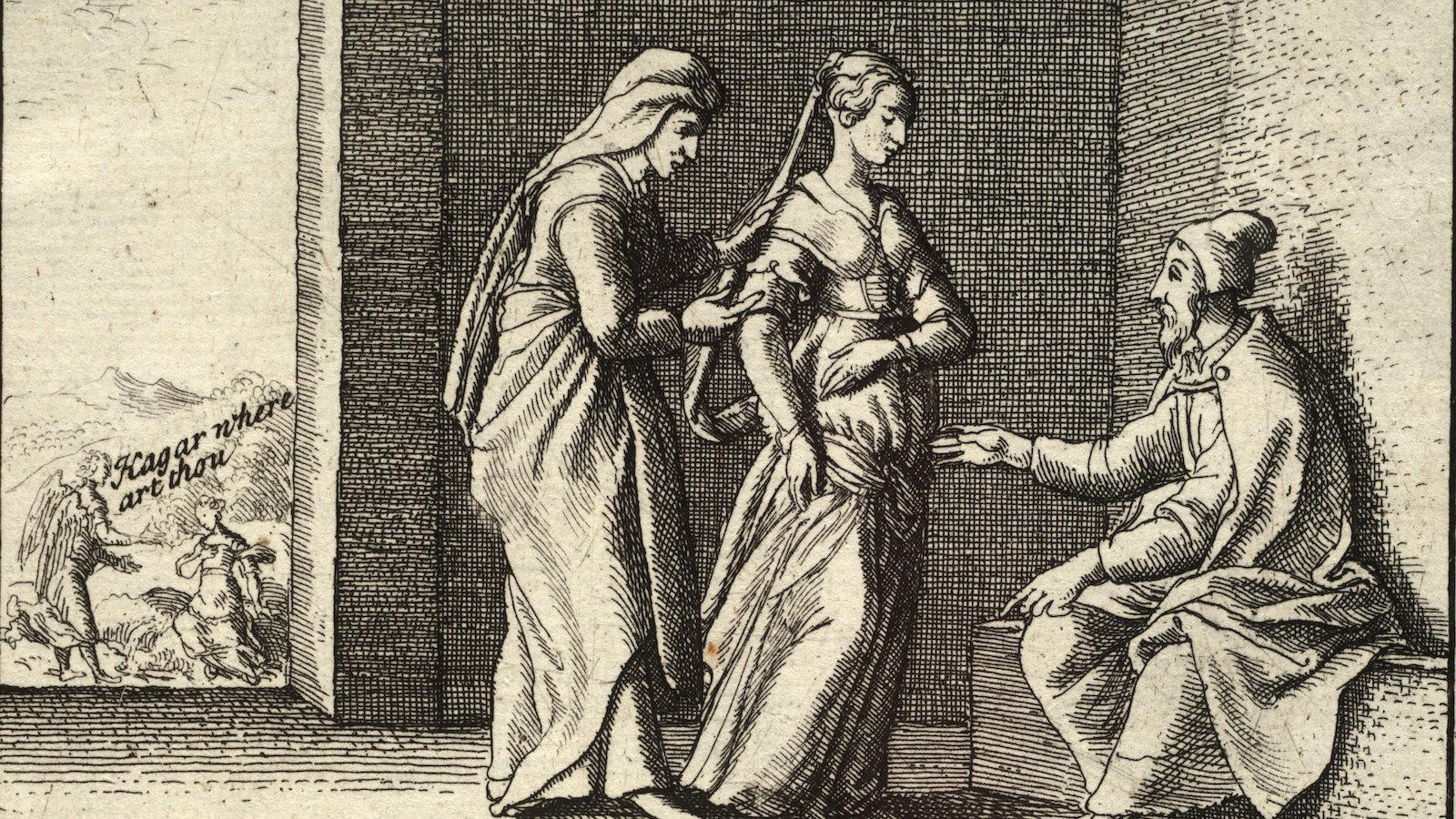Genesis contains the greatest concentration of female figures in the Bible (32 named and 46 unnamed women). The fact that Genesis consists of a series of family stories (including several genealogies) accounts for the remarkable concentration of female figures. These stories are generally understood by scholars as legends, but that does not sever their link with history.
The families depicted in Genesis may or may not represent actual people, but these literary portraits are valuable sources for understanding the general social and cultural world that produced them. And clues from the larger realm of ancient Near Eastern history can help us understand biblical characters.
Biblical Sarah
Biblical Sarah, Abraham’s wife and the matriarch of the Jewish people, is a strong and independent character. When she cannot have children, Sarah takes the initiative and gives her maid-servant, Hagar, to Abraham so that he can have children through Hagar on Sarah’s behalf.
Hagar becomes pregnant, and Sarah sees that she “is diminished” in Hagar’s eyes (Genesis 16:4). Sarah brings this problem to Abraham, and Abraham, rather than deciding himself what to do, lets Sarah choose how to deal with Hagar, saying: “Here, your slave-woman is in your hands. Do to her what is good in your eyes” (Genesis 16:6).
With your help, My Jewish Learning can provide endless opportunities for learning, connection and discovery.
Sarah abuses Hagar, and Hagar flees. Hagar comes across a spring, where an angel of God appears to her. The angel promises her that her descendants will become a great nation, and he orders her to return to Abraham. Hagar returns and gives birth to a son, Ishmael.
At Isaac’s weaning ceremony, Sarah sees Ishmael “playing” (it is unclear exactly what he was doing) and again, Sarah takes the initiative. She asks Abraham to send Ishmael away. Abraham is reluctant to do so, but God tells him: “Whatever Sarah tells you to do, listen to her” (Genesis 21:12), and he agrees and sends Hagar and her son away.
In this story, Sarah acts independently, taking the initiative to decide the future of her family, even against her husband’s wishes. How can we account for Sarah’s independent behavior in the patriarchal biblical world in which she lived? Why does Sarah, the woman, act to determine her family’s future while her husband, Abraham, is passive?
Savina J. Teubal, in Sarah the Priestess, and Tikva Frymer-Kensky, in Reading the Women of the Bible, both draw on historical evidence from the ancient Near East in order to address this question, but come to different conclusions.
Sarah the Priestess
Teubal argues that Sarah, in taking this active role in the Hagar story, is preserving the ancient Mesopotamian tradition of priestesses, a privileged class of women who play a greater role than their husbands in directing their families’ lives. Sarah, she explains, was a priestess in Mesopotamia, before she chose to leave her family and homeland behind and journey with Abraham to Canaan.
Archaeological evidence shows that both Ur and Haran, the cities from which Sarah and Abraham emigrated, were centers of goddess worship; pictures of Mesopotamian goddesses appear on pottery plaques unearthed from both areas. Once Sarah arrives in Canaan, argues Teubal, she struggles to preserve the matriarchal traditions of her homeland against the patriarchal society in Canaan. The Genesis narratives thus form a bridge between the matriarchal pre-historic world and the patriarchal historic world.
Teubal draws on historical evidence from the ancient Near East to prove that, in the Hagar story, Sarah asserts her traditional role as priestess. Teubal cites Paragraph 146 of Hammurabi’s Code, an ancient Mesopotamian legal code:
If a man has married a priestess [of a certain rank] and she has given a slave girl to her husband and she bears sons, if (thereafter) that slave girl goes about making herself equal to her mistress, because she had borne sons, her mistress may not sell her; she may put the mark of a slave on her and count her with the slave girls. If she has not borne sons, her mistress may sell her.
In treating Hagar as she does, Sarah asserts the authority granted to her as priestess by the legal code of her homeland. Sarah takes her maid and gives her as a concubine to her husband. When Hagar conceives, she “goes about making herself equal to her mistress”– Sarah is lowered in her eyes–so Sarah “puts the mark of a slave on her” by abusing Hagar.
Although Teubal cites an impressive array of circumstantial evidence for her theory that Sarah is a Mesopotamian priestess, there is no direct evidence in the biblical text. Is there another way to account for Sarah’s active role in the Hagar story?
Sarah as Paradigm
Frymer-Kensky provides a different theory to explain Sarah’s behavior. She argues that written records from the beginning of writing in ancient Sumer show that patriarchy was well-entrenched in the ancient Near East over 1500 years before the Bible; the Genesis narratives are not a bridge between some matriarchal pre-history and patriarchal history. Worship of goddesses did not lessen the actual social subordination of women. How then can we understand the active, independent role of Sarah and the other matriarchs in directing they and their family’s lives?
Frymer-Kensky argues that although the Bible portrays a patriarchal social structure, it has a gender-neutral ideology. The women in the Bible are socially subordinate but not essentially inferior; they have strong, independent personalities, and they often act to guide the course of events.
Why does the Bible portray women in such a positive light? Frymer-Kensky explains that women serve as a paradigm for the people of Israel after the destruction of the Temple and the expulsion from the land of Israel. The Bible, through its portrayal of female characters, provides a model for how the people of Israel, despite their lack of political power, are not essentially inferior and can play an active role in determining history.
Frymer-Kensky interprets the story of Hagar in keeping with this theory. Like Teubal, she cites historical evidence from the ancient Near East in her interpretation. She explains that Sarah gives Hagar to Abraham in keeping with ancient Near Eastern tradition. Three ancient Near Eastern marriage contracts state that if the wife remains barren after a specified number of years, she gives her husband her slave to have children on her behalf. Frymer-Kensky also cites the passage from Hammurabi’s Code regarding the priestess, but she does not conclude from this parallel that Sarah was a priestess; the other marriage contracts describe a similar situation, and they do not refer to priestesses.
If Sarah is merely acting according to ancient Near Eastern law, what is the significance of the Hagar story? Frymer-Kensky argues that Hagar, too, symbolizes Israel. Just as God tells Abraham that He will multiply Abraham’s progeny, but first his descendants will be degraded slaves, so too God promises Hagar that He will multiply her progeny, but first she must return to Abraham to be exploited as a slave. Hagar’s story shows that the path to redemption leads first through degradation.
Frymer-Kensky and Teubal both use historical evidence from the ancient Near East to come to different conclusions regarding the Sarah-Hagar story. Teubal argues that Sarah is asserting her traditional role as Mesopotamian priestess, while Frymer-Kensky argues that both Sarah and Hagar serve as paradigms for Israel: one exercising great influence despite her secondary social status, the other beginning a journey to redemption. Frymer-Kensky and Teubal’s differing interpretations of the Sarah-Hagar story provide two ways to understand the strong and independent women of the Bible in the context of the patriarchal world in which they lived.



